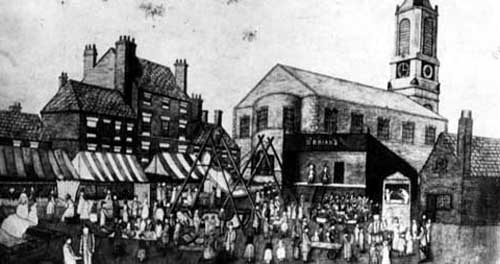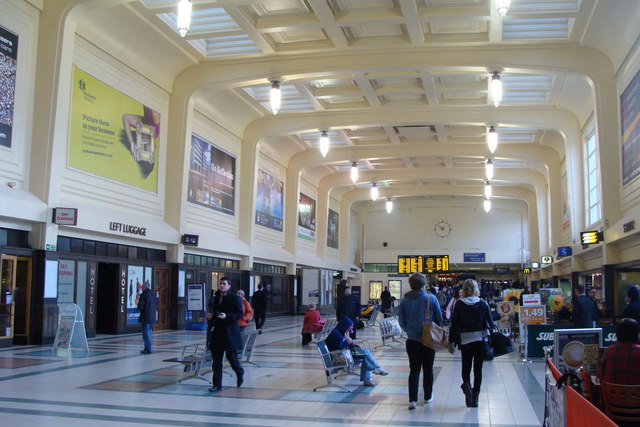|
Hallam Line
The Hallam Line is a railway connecting Leeds and Sheffield via Castleford in the West Yorkshire Metro area of northern England. It is a slower route from Leeds to Sheffield than the Wakefield line. Services on this line are operated by Northern. Services from Leeds to Nottingham also use the line. West Yorkshire MetroCards are available on trains between Leeds and Darton, north of Barnsley and South Yorkshire Travelmaster tickets are available in the South Yorkshire area. Origin of name The line is named after the manor of Hallam which included Sheffield at the time of the Domesday Book (1086). At this time the local area was known as ''Hallamshire''—the names ''Hallam'' and ''Hallamshire'' are still used today by many local companies and organisations. History Before the 1923 grouping the route followed by the line was owned as follows: * Leeds–Methley: Midland Railway * Methley–Normanton: Midland Railway * Methley–Castleford–Normanton: North Eastern Railway : ... [...More Info...] [...Related Items...] OR: [Wikipedia] [Google] [Baidu] |
West Yorkshire
West Yorkshire is a metropolitan and ceremonial county in the Yorkshire and Humber Region of England. It is an inland and upland county having eastward-draining valleys while taking in the moors of the Pennines. West Yorkshire came into existence as a metropolitan county in 1974 after the reorganisation of the Local Government Act 1972 which saw it formed from a large part of the West Riding of Yorkshire. The county had a recorded population of 2.3 million in the 2011 Census making it the fourth-largest by population in England. The largest towns are Huddersfield, Castleford, Batley, Bingley, Pontefract, Halifax, Brighouse, Keighley, Pudsey, Morley and Dewsbury. The three cities of West Yorkshire are Bradford, Leeds and Wakefield. West Yorkshire consists of five metropolitan boroughs (City of Bradford, Calderdale, Kirklees, City of Leeds and City of Wakefield); it is bordered by the counties of Derbyshire to the south, Greater Manchester to the south-west, Lancash ... [...More Info...] [...Related Items...] OR: [Wikipedia] [Google] [Baidu] |
Midland Railway
The Midland Railway (MR) was a railway company in the United Kingdom from 1844. The Midland was one of the largest railway companies in Britain in the early 20th century, and the largest employer in Derby, where it had its headquarters. It amalgamated with several other railways to create the London, Midland and Scottish Railway at grouping in 1922. The Midland had a large network of lines emanating from Derby, stretching to London St Pancras, Manchester, Carlisle, Birmingham, and the South West. It expanded as much through acquisitions as by building its own lines. It also operated ships from Heysham in Lancashire to Douglas and Belfast. A large amount of the Midland's infrastructure remains in use and visible, such as the Midland main line and the Settle–Carlisle line, and some of its railway hotels still bear the name '' Midland Hotel''. History Origins The Midland Railway originated from 1832 in Leicestershire / Nottinghamshire, with the purpose of serving the needs o ... [...More Info...] [...Related Items...] OR: [Wikipedia] [Google] [Baidu] |
Hunslet
Hunslet () is an inner-city area in south Leeds, West Yorkshire, England. It is southeast of the Leeds city centre, city centre and has an industrial past. It is situated in the Hunslet and Riverside (ward), Hunslet and Riverside ward of Leeds City Council and Leeds Central (UK Parliament constituency), Leeds Central parliamentary constituency. The population of the previous City and Hunslet council ward at the 2011 census was 33,705. Many engineering companies were based in Hunslet, including John Fowler & Co. manufacturers of traction engines and steam rollers, the Hunslet Engine Company builders of locomotives (including those used during the construction of the Channel Tunnel), Kitson & Co., Manning Wardle and Hudswell Clarke. Many railway locomotives were built in the Jack Lane area of Hunslet. The area has a mixture of modern and 19th century industrial buildings, terraced house, terraced housing and 20th century housing. It is an area that has grown up significantly a ... [...More Info...] [...Related Items...] OR: [Wikipedia] [Google] [Baidu] |
Bradford
Bradford is a city and the administrative centre of the City of Bradford district in West Yorkshire, England. The city is in the Pennines' eastern foothills on the banks of the Bradford Beck. Bradford had a population of 349,561 at the 2011 census; the second-largest population centre in the county after Leeds, which is to the east of the city. It shares a continuous built-up area with the towns of Shipley, Silsden, Bingley and Keighley in the district as well as with the metropolitan county's other districts. Its name is also given to Bradford Beck. It became a West Riding of Yorkshire municipal borough in 1847 and received its city charter in 1897. Since local government reform in 1974, the city is the administrative centre of a wider metropolitan district, city hall is the meeting place of Bradford City Council. The district has civil parishes and unparished areas and had a population of , making it the most populous district in England. In the century leadin ... [...More Info...] [...Related Items...] OR: [Wikipedia] [Google] [Baidu] |
Leeds Railway Station
Leeds railway station (also known as Leeds City railway station) is the mainline railway station serving the city centre of Leeds in West Yorkshire, England. It is the fourth-busiest railway station in the UK outside London (as of March 2020). It is located on New Station Street to the south of City Square, at the foot of Park Row, behind the landmark Queens Hotel. It is one of 20 stations managed by Network Rail. Leeds is an important hub on the British rail network. The station is the terminus of the Leeds branch of the East Coast Main Line (on which London North Eastern Railway provides high speed inter-city services to every half hour from the station) and is an important stop on the Cross Country Route between Scotland, the Midlands and South West England connecting to major cities such as Birmingham, Glasgow, Edinburgh, Derby, Bristol, Exeter, Plymouth and Penzance. There are also regular inter-city services to major destinations throughout Northern England including Manc ... [...More Info...] [...Related Items...] OR: [Wikipedia] [Google] [Baidu] |
Leeds RJD 40
Leeds () is a city and the administrative centre of the City of Leeds district in West Yorkshire, England. It is built around the River Aire and is in the eastern foothills of the Pennines. It is also the third-largest settlement (by population) in England, after London and Birmingham. The city was a small manorial borough in the 13th century and a market town in the 16th century. It expanded by becoming a major production centre, including of carbonated water where it was invented in the 1760s, and trading centre (mainly with wool) for the 17th and 18th centuries. It was a major mill town during the Industrial Revolution. It was also known for its flax industry, iron foundries, engineering and printing, as well as shopping, with several surviving Victorian era arcades, such as Kirkgate Market. City status was awarded in 1893, a populous urban centre formed in the following century which absorbed surrounding villages and overtook the nearby York population. It is located ab ... [...More Info...] [...Related Items...] OR: [Wikipedia] [Google] [Baidu] |
Barnsley Court House Railway Station
Barnsley Court House railway station was a railway station in Barnsley, South Yorkshire, England. It closed in 1960. Before this station was built the Midland Railway's Barnsley station was at Cudworth on the former North Midland Railway's line between Leeds and Derby. To reach the town, in the 1860s, the Midland opened a line from Cudworth South Junction to Barnsley and a new, albeit temporary, station Regent Street railway station, in Barnsley, South Yorkshire, was opened. The new station was made necessary due to the cramped conditions at Barnsley Exchange station. The Midland opened the line for goods traffic in April 1869 and for passengers on 1 May the following year, the delay being caused by a signalling dispute with the MS&LR over the connection at Pindar Oaks. The facilities were on an elevated site which was immediately West of Barnsley Exchange. The Midland Railway built a new passenger station on the Regent Street site and this opened for business on 23 Augu ... [...More Info...] [...Related Items...] OR: [Wikipedia] [Google] [Baidu] |
London, Midland And Scottish Railway
The London, Midland and Scottish Railway (LMSIt has been argued that the initials LMSR should be used to be consistent with LNER, GWR and SR. The London, Midland and Scottish Railway's corporate image used LMS, and this is what is generally used in historical circles. The LMS occasionally also used the initials LM&SR. For consistency, this article uses the initials LMS.) was a British railway company. It was formed on 1 January 1923 under the Railways Act of 1921, which required the grouping of over 120 separate railways into four. The companies merged into the LMS included the London and North Western Railway, Midland Railway, the Lancashire and Yorkshire Railway (which had previously merged with the London and North Western Railway on 1 January 1922), several Scottish railway companies (including the Caledonian Railway), and numerous other, smaller ventures. Besides being the world's largest transport organisation, the company was also the largest commercial enterprise ... [...More Info...] [...Related Items...] OR: [Wikipedia] [Google] [Baidu] |





.jpg)

